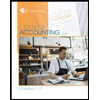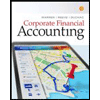
Concept explainers
Recording Transactions Affecting Stockholders’ Equity
King Corporation began operations in January of the current year. The charter authorized the following stock:
Common stock: $5 par value, 85,000 shares authorized
During the current year, the following transactions occurred in the order given:
- a. Issued 66,000 shares of common stock for $9 cash per share.
- b. Sold 9,000 shares of the preferred stock at $20 cash per share.
- c. Sold 1,000 shares of the preferred stock at $20 cash per share and 2,500 shares of common stock at $10 cash per share.
Required:
Provide the
Prepare the journal entries for given transaction.
Explanation of Solution
Common stock:
These are the ordinary shares that a corporation issues to the investors in order to raise funds. In return, the investors receive a share of profit from the profits earned by the corporation in the form of dividend.
Par value:
It refers to the value of a stock that is stated by the corporation’s charter. It is also known as face value of a stock.
Journal:
Journal is the method of recording monetary business transactions in chronological order. It records the debit and credit aspects of each transaction to abide by the double-entry system.
Rules of Debit and Credit:
Following rules are followed for debiting and crediting different accounts while they occur in business transactions:
- Debit, all increase in assets, expenses and dividends, all decrease in liabilities, revenues and stockholders’ equities.
- Credit, all increase in liabilities, revenues, and stockholders’ equities, all decrease in assets, expenses.
Journal entries for given transaction are as follows:
a. Issued 66,000 common shares at $9 per share:
| Date | Accounts title and explanation | Ref. | Debit ($) | Credit ($) |
| Cash (+A) (2) | 594,000 | |||
| Common stock (+SE) (1) | 330,000 | |||
| Additional paid-in capital, common stock (+SE) (3) | 264,000 | |||
| (To record the issuance of common stock) |
Table (1)
- Cash is an assets account and it increased the value of asset by $594,000. Hence, debit the cash account for $594,000.
- Common stock is a component of stockholder’s equity and it increased the value of stockholder’s equity by $330,000. Hence, credit the common stock for $330,000.
- Additional paid-in capital is a component of stockholder’s equity and it increased the value of stockholder’s equity by $264,000. Hence, credit the additional paid-in capital for $264,000.
Working note:
Calculate the value of common stock
Calculate the total cash received
Calculate the value of additional paid in capital
b. Issued 9,000 shares of preferred stock at $20 each:
| Date | Accounts title and explanation | Ref. | Debit ($) | Credit ($) |
| Cash (+A) (5) | 180,000 | |||
| Preferred stock (+SE) (4) | 90,000 | |||
| Additional paid-in capital, preferred stock (+SE) (6) | 90,000 | |||
| (To record the issuance of preferred stock) |
Table (2)
- Cash is an assets account and it increased the value of asset by $180,000. Hence, debit the cash account for $180,000.
- Preferred stock is a component of stockholder’s equity and it increased the value of stockholder’s equity by $90,000. Hence, credit the preferred stock for $90,000.
- Additional paid-in capital, preferred stock is a component of stockholder’s equity and it increased the value of stockholder’s equity by $90,000. Hence, credit the additional paid-in capital, preferred stock account for $90,000.
Working note:
Calculate the value of preferred stock
Calculate the total cash received
Calculate the value of additional paid in capital, preferred stock
c. Issued 2,500 common shares at $10 per share and issued 1,000 shares of preferred stock at $20 each:
| Date | Accounts title and explanation | Ref. | Debit ($) | Credit ($) |
| Cash (+A) (13) | 45,000 | |||
| Preferred stock (+SE) (7) | 10,000 | |||
| Common stock (+SE) (10) | 12,500 | |||
| Additional paid-in capital, preferred stock (+SE) (9) | 10,000 | |||
| Additional paid up capital, common stock(+SE) (12) | 12,500 | |||
| (To record issuance of common stock and preferred stock) |
Table (3)
- Cash is an assets account and it increased the value of asset by $45,000. Hence, debit the cash account for $45,000.
- Preferred stock is a component of stockholder’s equity and it increased the value of stockholder’s equity by $10,000. Hence, credit the preferred stock for $10,000.
- Common stock is a component of stockholder’s equity and it increased the value of stockholder’s equity by $12,500, Hence, credit the common stock for $12,500.
- Additional paid-in capital, preferred stock is a component of stockholder’s equity and it increased the value of stockholder’s equity by $10,000. Hence, credit the additional paid-in capital, preferred stock account for $10,000.
- Additional paid up capital, common stock is a component of stockholder’s equity and it increased the value of stockholder’s equity by $12,500. Hence, credit the additional paid up capital, common stock account for $12,500.
Working note:
Calculate the value of preferred stock
Calculate the cash received from preferred stock
Calculate the value of additional paid in capital, preferred stock
Calculate the value of common stock
Calculate the cash received from common stock
Calculate the value of additional paid in capital
Calculate the value of total cash received from preferred stock and common stock
Want to see more full solutions like this?
Chapter 11 Solutions
Financial Accounting
- I need help with accountingarrow_forwardWhich entry is correct for recording revenue earned on account?A. Debit Cash, Credit RevenueB. Debit Revenue, Credit Accounts ReceivableC. Debit Accounts Receivable, Credit RevenueD. Debit Unearned Revenue, Credit Cash Needarrow_forward8 Which statement about "common shares" is correct? Question 8 options: Common shares have the highest priority of all shares issued by a company. Common shares have the lowest priority of all shares issued by a company. Common shares have the lowest claim to residual ownership interest of all shares. Common shares have no claim to residual ownership interest of all shares.arrow_forward
- 19 FAST Jetski Corp. has sold motorized watercraft for a number of years. FAST Jetski includes a three-year warranty on each watercraft they sell. Management estimates that the cost of providing the warranty coverage is 2% of sales in the first year and 3% of sales in each of years two and three. Other facts follow: • FAST Jetski reported a $270,000 provision for warranty payable on its December 31, 2025 balance sheet.• FAST Jetski's sales for 2026 totalled $6,000,000 spread evenly through the year.• The cost to FAST Jetski of meeting their warranty claims in 2026 was $480,000; $300,000 for parts and $180,000 for labour.• FAST Jetski's sales for 2027 totalled $6,200,000 spread evenly through the year.• The cost to FAST Jetski of meeting their warranty claims in 2027 was $468,000; $280,800 for parts and $187,200 for labour. Based on recent claims history, FAST Jetski revises their 2027 warranty provision to 9% of sales. Required1. Prepare summary journal entries to…arrow_forward10 Which method must be used under ASPE to account for employee stock options? Question 10 options: Time value of options. Market value of the shares. Fair value of the options. Intrinsic value of options.arrow_forward12 Calculate the share effect on the incremental EPS for the following instrument: Convertible bonds outstanding, yield of 5% and coupon rate of 5% $2,000,000 Issue date January 1, 2026 Maturity date December 31, 2033 Conversion rate for each $1,000 bond 40 ordinary shares Income tax rate 25% Question 12 options: 0.63 0.94 75,000 80,000arrow_forward
- Please provide the correct answer to this general accounting problem using accurate calculations.arrow_forward4 Why do bonds often include covenants? Question 4 options: To reduce information asymmetry. To compensate for value-added services. To ensure repayment of the bond. To reduce moral hazard.arrow_forward17 If a company provides a non-contributory pension plan, who makes the contributions? Question 17 options: Only the employee. Both the employer and employee. No one. Only the employer.arrow_forward
- 9 Assume that on January 15, 2025, Ariel agrees to purchase US$500,000 for C$550,000 for delivery on January 15, 2026. The exchange rate at its December 31 year-end is US$1 = C$0.95 and on January 15, 2026, the exchange rate is US$1 = C$0.97. What is the foreign exchange gain or loss recognized on January 15, 2025? Question 9 options: 0 $75,000 gain. $75,000 loss. $65,000 loss.arrow_forward18 Stranger Things Inc. (STI) had 80,000 ordinary shares outstanding on January 1, 2026. Transactions throughout 2026 affecting its shareholdings follow. • February 1: STI issued 200,000, $10, cumulative 10% preferred shares.• March 1: STI issued 40,000 ordinary shares.• April l: STI declared and issued an 8% stock dividend on the ordinary shares.• July 1: STI repurchased and cancelled 30,000 ordinary shares.• October 1: STI declared and issued a 3-for-l stock split on the ordinary shares.• December 31: STI declared $99,600 in dividends on the ordinary shares.• Net income for the year ended December 31, 2026, was $600,000. Its tax rate was 40%.Required1. What was weighted average number of ordinary shares outstanding in 2026?2. What was basic EPS in 2026?arrow_forward16 Which of the following best describes a "defined benefit plan"? Question 16 options: A pension plan that specifies how much funds the employee needs to contribute. A plan that requires the employer to contribute $10 per hour worked by an employee. A plan that specifies how much in pension payments employees will receive in their retirement. High returns in the pension plan result in higher benefit payments to the employees in the future.arrow_forward
 Financial And Managerial AccountingAccountingISBN:9781337902663Author:WARREN, Carl S.Publisher:Cengage Learning,
Financial And Managerial AccountingAccountingISBN:9781337902663Author:WARREN, Carl S.Publisher:Cengage Learning, Financial AccountingAccountingISBN:9781337272124Author:Carl Warren, James M. Reeve, Jonathan DuchacPublisher:Cengage Learning
Financial AccountingAccountingISBN:9781337272124Author:Carl Warren, James M. Reeve, Jonathan DuchacPublisher:Cengage Learning Accounting (Text Only)AccountingISBN:9781285743615Author:Carl Warren, James M. Reeve, Jonathan DuchacPublisher:Cengage Learning
Accounting (Text Only)AccountingISBN:9781285743615Author:Carl Warren, James M. Reeve, Jonathan DuchacPublisher:Cengage Learning College Accounting, Chapters 1-27 (New in Account...AccountingISBN:9781305666160Author:James A. Heintz, Robert W. ParryPublisher:Cengage Learning
College Accounting, Chapters 1-27 (New in Account...AccountingISBN:9781305666160Author:James A. Heintz, Robert W. ParryPublisher:Cengage Learning Corporate Financial AccountingAccountingISBN:9781305653535Author:Carl Warren, James M. Reeve, Jonathan DuchacPublisher:Cengage LearningPrinciples of Accounting Volume 1AccountingISBN:9781947172685Author:OpenStaxPublisher:OpenStax College
Corporate Financial AccountingAccountingISBN:9781305653535Author:Carl Warren, James M. Reeve, Jonathan DuchacPublisher:Cengage LearningPrinciples of Accounting Volume 1AccountingISBN:9781947172685Author:OpenStaxPublisher:OpenStax College





